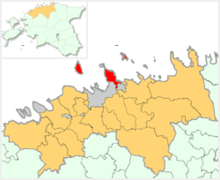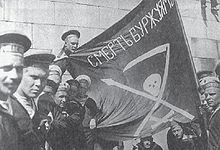Naissaar



Naissaar (

Until the
Although the fortifications on the island date back to Peter the Great's scheme to fortify Tallinn, the main fortifications are from the period of Russian rule before World War I. Today, the previous small houses of the Swedish villages are gradually being restored. Also being restored is a narrow gauge railway that runs from the north to the southern tip of the island.
A notable native of the island was
Lighthouse
Naissaar Lighthouse was first built in 1788, although the present lighthouse dates to 1960. It is 47 meters tall.
History
In Estonian the name of the island, Nais-saar, means 'island of women', and it is possible that Naissaar is the island the chronicle of Adam of Bremen mentioned around 1075 under the name Terra Feminarum. Estonian Swedish fishermen were well established on the island by the 15th century, and the Swedes erected a small fortress there in 1705 during the Great Northern War. After the war, Estonia became part of the Russian Empire. The tsar had a new fortress with five bastions built in 1720 for the defense of Tallinn and St. Petersburg.
A
In 1850 the island's population was 155 people, and by 1858 it had grown to 188, most of whom were Estonian Swedes. Between 1853 and 1856, the inhabitants built a new chapel that was part of the Swedish parish of St. Michael in Tallinn.
In the early twentieth century, Russia began modernizing its fortifications in the Gulf of Finland. However, the outbreak of the First World War stopped the planned improvements for Naissaar. Nonetheless, in 1914 the Russians opened a narrow-gauge railway line, with a total trackage of 37.7 km.
Soviet Republic of Naissaar

The Ukrainian
The Council began drafting a constitution, the capital was designated the Southern Village and the anthem "The Internationale". The flag became the red-black flag of anarcho-syndicalism. It was also intended to issue its own money, but the name of the units is unknown.[3] The Soviet Republic of Naissaar was also recognized, at least de facto, by the workers' government in mainland Estonia, who sent prisoners to the island "to fortify some of the castles, clear the railroads, carry snow and dig sand."[4]

At this point the newly formed
Between the wars
The Estonian government executed forty Bolshevik prisoners of war here in February 1919.
World War II
The Red Army occupied Naissaar in 1940, only to have the Wehrmacht displace it a few months later. The population of Swedish fishermen preferred the Germans, and when the Red Army drove the Germans out in 1944, the last of the Swedish-speaking fishermen took refuge in Sweden.
Post-war

During the period of the Estonian Soviet Socialist Republic, the Soviet Union established its largest factory for naval mines in the Baltic on the island. The Soviets therefore declared the island a military area and off-limits to the public. The Soviets also used the railway to connect the factory to the port.
Post-Soviet period
When the Soviets left Naissaar in early 1993, they burned the explosives in the naval mines, leaving a multitude of metal casings scattered throughout the island. Many of these were scavenged as scrap iron, but a field of mines is still visible near the wharf at Mädasadam. Another legacy of the arms industry is that the soil of the island remains contaminated by oil and heavy metals.
In 1995 Naissaar Landscape Conservation Area was established, occupying the entire area of the island.
The Naissaar Museum, presenting the military history of the island, is located in Lõunaküla.[8]
Gallery
-
Naissaare lighthouse
-
Naissaare harbour light beacon
-
Omari barn
-
Memorial stone in cemetery
-
South coast of Naissaar
-
Naissaare Church
Citations
- ^ "Naissaare". Dictionary of Estonian Place Names. Tallinn: Eesti Keele Instituut. Retrieved 4 April 2024.
- ^ Itse, Birgit (January 2005). "Jalutuskäik saladusliku Naissaare lõunarajal". Eesti Loodus (in Estonian). Retrieved 24 October 2007.
- ^ a b c d Popławski, Kazimierz (6 November 2017). "Naissar: the Estonian "Island of Women", Once an Independent Socialist Republic". Deep Baltic. Translated by Ostrowska, Martyna. Archived from the original on 16 July 2019. Retrieved 16 July 2019.
- ^ a b c "Naissaare kroonika" (in Estonian). Archived from the original on 6 March 2005. Retrieved 24 October 2007.: "nõukogu kuulutab saare soldatite ja kindluseehitajate sotsialistlikuks vabariigiks."
- ISBN 978-0-312-22598-8.
- ISBN 978-90-13-03468-4.
- ^ Jackson, Battle of the Baltic, page 9
- ^ "Museum of Naissaar". Rannarahva Muuseum. Retrieved 4 April 2024.






